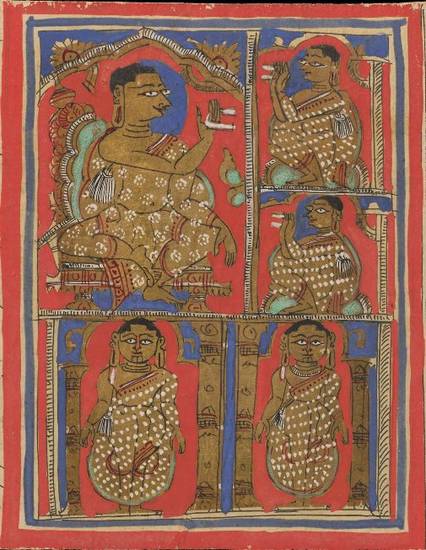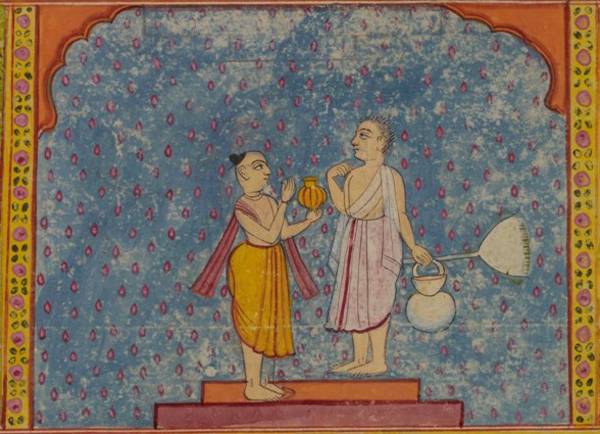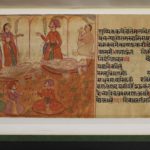Article: The ‘Perfect Ascetic’
The general term for Jain monks and nuns is ‘ascetic’ or ‘mendicant’. They are people who have completed the official initiation ceremony called dīkṣā and live according to monastic rules. These include general rules of mendicant life and specific rules according to the mendicant’s sect and monastic order. The ‘perfect ascetic’ is a monk or nun who observes all the rules and does not behave in any way like a lay person.
The life of a mendicant is hard, both physically and mentally, and the rules regulating monastic life are intended to help them fulfil the ‘five great vows’ – mahā-vratas – and to gain complete detachment. There are rules for each area of daily life. They are listed in various groups, which overlap to some extent. Meant to be memorised, these lists are strings of key words, each representing detailed content.
One of the main Śvetāmbara works on this concept is the Uttarādhyayana-sūtra, a scripture of the Śvetāmbara sect. It deals with ‘the true monk’ in the 15th chapter and with the ‘bad ascetic’ in the 17th. The other chapters also set out what monastic life should be. For example, chapter 26 gives the components of ‘correct behaviour’ – sāmācārī – while chapter 31 describes the ‘mode of conduct’ – caraṇavidhi – by listing elements of behaviour. The lists are arranged in order of length, starting with the smallest number. Chapter 35 again takes up the subject of the ideal mendicant, discussing what the ‘houseless monk’ should do.
Monks and nuns have renounced the householder life to make spiritual progress. Underlying a large part of the monastic lifestyle is the principle of detachment, which mendicants try to act out in their lives. They should be constantly aware of their physical and mental actions, so they can exercise full self-control. Renunciation means rejecting or, at least, controlling all attachments to the world, including physical needs and emotions. Being completely detached is necessary to achieving the total calmness or equanimity needed to get rid of old karma and avoid attracting new karma. Only individuals who have no karma can reach final liberation from the cycle of birth. The ‘perfect ascetic’ advances a long way towards this goal.
Carefulness and self-control
Permanent carefulness and vigilance are the main principles underlying ascetic behaviour. Mendicants should always be alert and conscious of what they think, do and say. This is the only way to be self-controlled all the time. Energy is also needed to gain full self-control, as this extract shows:
One cannot quickly arrive at discernment; therefore one should exert one’s self, abstain from pleasures, understand the world, be impartial like a sage, and guard one’s self: thus never be careless.
Uttarādhyayana-sūtra, chapter 4, verse 10
translation by Hermann Jacobi
The ’causes of carelessness’ are the focus of chapter 32 of this work.
By and large, all the vows and rules are developments and applications of these principal qualities.
Respect for a superior
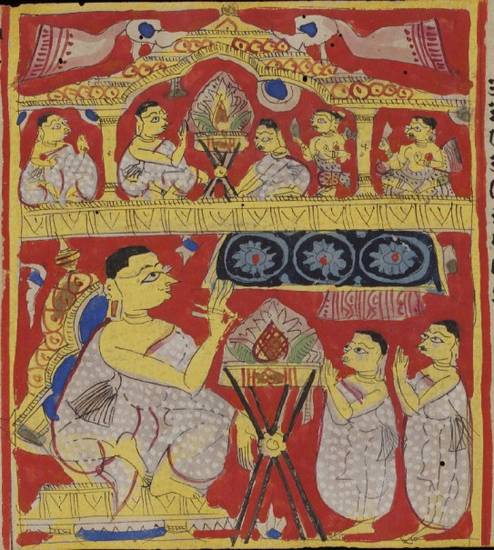
Senior monk teaching
Image by Victoria and Albert Museum © V&A Images/Victoria and Albert Museum, London
Jain monastic communities are organised in hierarchical groups. Where a monk or nun fits into the hierarchy depends on the individual’s length of time as a mendicant, sex and office. Ordinary monks and nuns defer to those who have been monks and nuns for longer and to those who hold an official position. Nuns are always lower in rank than monks, even if they have been mendicants for longer and hold office.
The concept of deference – vinaya – to one’s superior is a basic one in daily life. Mendicants are advised to be silent and ready to learn from more experienced ascetics and also to serve them. When they are rebuked, they should not show anger.
In practice this means that a mendicant’s teacher or superior will sit on a slightly raised seat, whereas junior ascetics will sit on the ground. They are not allowed to sit higher or on the same level as the teacher. Modesty and obedience are the rules for all monks and nuns, but especially for low-ranking mendicants.
Chapter 1 of the Uttarādhyayana-sūtra, a fundamental scripture of the Śvetāmbaras regarding the basics of the ascetic life, is dedicated to this topic. Conversely, bad ascetics are those who behave disrespectfully towards their superiors, answer inappropriately or even hit them.
‘Five Great Vows’
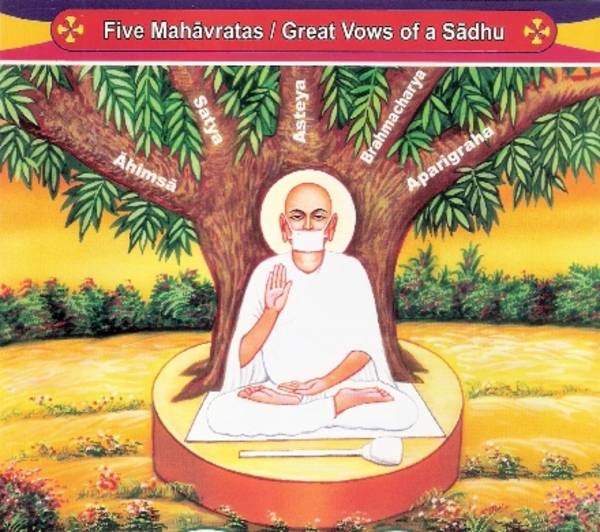
‘Five Great Vows’
Image by Shree Diwakar Prakashan © public domain
As part of their initiation, monks and nuns swear to follow these ‘absolute’ vows – mahā-vratas:
- Non-violencenon-violence – ahiṃsā
- truth – satya
- non-stealing – acaurya or asteya
- celibacy – brahmacarya
- non-attachment or non-possession – aparigraha.
This is the traditional order in which the vows are listed. They were clearly set out by the 24th Jina Māhavīra. Earlier, in the time of his predecessor, Pārśvanātha or Lord Pārśva, there were only four restraints, with the vow of celibacy included in that of non-possession.
Monks and nuns live according to these vows for the rest of their lives. It is often emphasised that the vow of celibacy is the most difficult of all.
It is very rare for a mendicant to return to the householder life.
‘Obligatory Actions’
The perfect ascetic should perform the six obligatory actions – āvaśyaka – on a daily basis. They imply a ritual involving gestures and speaking certain phrases. They are:
- attainment of calmness – sāmāyika
- praising the 24 Jinas – caturviṃśati-stava
- veneration of mendicants – vandana
- repentance – pratikramaṇa – for all the lapses that might have happened during the past day, night, fortnight or month, depending on the kind of repentance concerned
- ascetic posture signifying the rejection of the body – kāyotsarga
- renouncing certain foods or activities for a defined period of time – pratyākhyāna.
The action of repentance is the central duty and the main ritual mendicants perform each day. Lay devotees may also perform pratikramaṇa daily.
This set of actions is part of the daily routine of the perfect ascetic, as explained in chapter 26 of the Uttarādhyayana-sūtra, which is the classic work on the topic. Chapter 29, called ‘The Exertion in Righteousness’, is another description of all the elements that make up the life of a perfect ascetic.
‘Protections’
The five great vows fix the general framework for ascetics’ behaviour, but there are other categories of rules that are meant to regulate all the activities of a mendicant’s life. These rules are intended to stop more karma becoming attached to the soul or to get rid of the karma that is already there.
The three ‘protections’ – gupti – are one group of such rules. They relate to:
- mind – manas
- speech – vāk
- body – kāya.
This is because using the mind, speech and body are the three ways of causing action, which is a source of karma.
In practice, these rules mean giving up the idea of things that are not good and cultivating only good ones. This can be done through:
- concentration
- keeping silent or limiting speech
- thinking about what is to be done and what is not to be done.
‘Precautions’

Detail of a Śvetāmbara broom
Image by Nalini Balbir © Nalini Balbir
The ‘precautions’ – samiti – are a category of rules that complement the three ‘protections’ for monks and nuns. It is often said that the eight together form the groundwork for the regulation of monastic behaviour. They are treated in chapter 24 of the Uttarādhyayana-sūtra, a fundamental scripture of the Śvetāmbara sect regarding the basics of the ascetic life.
Although there is overlap between the two categories of ‘protections’ and ‘precautions’, there is also an important difference. In the ‘protections’ the most significant aspect is not doing wrong, whereas in the ‘precautions’ it is the positive quality of doing what is right that is essential.
The ‘precautions’ relate to five areas of daily life. The basic idea is that ascetics should always be extremely careful in whatever they do. The terms are rather general and their precise meanings have therefore been discussed throughout the tradition.
Care in movements – īryā
This rule means that ascetics should always walk slowly, without hurry, in case they harm other people or, more generally, living beings. For example, mendicants should always inspect their path so they do not destroy minute life-forms by accident.
Care in speaking – bhāṣā
The corresponding ‘protection’ emphasises knowing whether it is appropriate to speak. This ‘precaution’ relates to what is said and how it is delivered. Whatever monks and nuns say should be measured, beneficial and accurate.
Care in getting alms – eṣaṇā
This includes all rules on the seeking and receiving of alms. For instance, ascetics should be careful not to disturb lay people when visiting their houses on their daily alms rounds. The monks and nuns should accept only boiled water and food that has the qualities the rules require.
Care in picking up and placing things – ādāna
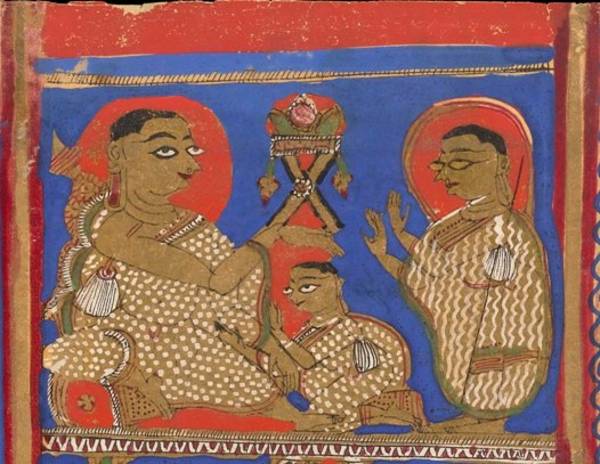
Scenes of forgiveness
Image by Wellcome Trust Library © Wellcome Library, London
Since this phrase is very general, it has given rise to different understandings. The main idea is that mendicants must be careful to avoid hurting minute life-forms. Thus the first thing ascetics should do when picking things up and placing them somewhere else is to carry out a preliminary inspection – pratilekhanā. Monks and nuns should examine both the objects and the place where they want to put them so that no living creature is injured by this activity.
In practice, the tradition understands that this rule relates to the monastic equipment all monks and nuns use. Thus the Śvetāmbara and Digambara understandings of the rule differ because their mendicants have different equipment.
Care in disposing of refuse – utsarga
Again the phrasing is very general, and the rule can apply to any type of refuse. Again, monks and nuns should first inspect the things to be disposed of and also the place where they will be put.
In practice, this rule relates to the disposal of bodily excretions such as saliva, mucus and human waste. Jain ascetics do not use toilets. So a proper place has to be selected, which should be free of living beings.
‘Discomforts’
The list of 22 discomforts or troubles – parīṣaha – refers to the difficulties monks and nuns have to bear. They must tolerate these discomforts to stay on the right path to spiritual development and annihilate karma, as this quotation from the Uttarādhyayana-sūtra states.
Twenty[-]two troubles which a monk must learn and know, bear and conquer, in order not to be vanquished by them when he lives the life of a wandering mendicant
Uttarādhyayana-sūtra, chapter 2
translation by Hermann Jacobi
These troubles form a set of factors or circumstances relating to situations ascetics face in daily life. Mendicants must try to stay unaffected by these troubles, because complete detachment from worldly concerns, pain and physical needs helps reduce karma.
|
Number |
Trouble |
Detail |
|---|---|---|
|
1 |
Hunger |
Monks and nuns should not eat more than the measure of food allowed by the rules. They should complete fasts they have vowed to keep without any break. |
|
2 |
Thirst |
Ascetics should bear the discomfort of thirst and should not drink cold water. This is forbidden, in case minute living beings are in the water. |
|
3 |
Cold |
Mendicants should not complain if they have to endure cold and should not think of making a fire to warm themselves. |
|
4 |
Heat |
Monks and nuns should not complain of the heat and should not think of fanning themselves or taking a bath. |
|
5 |
Insects |
Mendicants should tolerate insects, even if they are bitten. He [the monk] should not scare away insects, nor keep them off, or be in the least provoked to passion by them. Tolerate living beings, do not kill them, through they eat your flesh and blood. Uttarādhyayana-sūtra, chapter 2, verse 11 |
|
6 |
Nakedness |
Monks and nuns should not complain if their clothes are torn or damaged, wishing for new ones. |
|
7 |
Discontent |
Ascetics should bear the monastic life without feeling any discontent. |
|
8 |
Women |
Ascetics should not even think of women, as they are dangerous to the idea of staying in the monastic life. This rule is intended for monks, though this rule may be thought of as prohibiting sexual activity of any kind. |
|
9 |
Wandering life |
Monks and nuns should keep to this mode of life – vihāra – and not think of establishing themselves in the world and having some property. |
|
10 |
Places to sit |
Ascetics should sit anywhere suitable – a place that has first been inspected for life in the pratilekhanā. This means that they should be able to sit in places where others may not want to be. Mendicants must be able to sit in a burial-place, a deserted house or below a tree, alone, without fear, and without thinking that there could be better places. |
|
11 |
Lodging |
Whatever the standard, size or cleanliness of the lodging, monks and nuns should be satisfied. |
|
12 |
Abuse |
Ascetics should tolerate abuses or cruel words from lay people without becoming angry. Otherwise, they are behaving like small children. |
|
13 |
Strikes and blows |
Mendicants should bear physical blows or attacks in a spirit of resignation, thinking, ‘I have not lost my life.’ |
|
14 |
Asking for something |
Monks and nuns should not ask for anything, even if lay people are not well disposed towards them. |
|
15 |
Not getting alms |
Even if the alms round has been unsuccessful, ascetics should tolerate it without any reaction and without suffering. They must think, ‘I get nothing today, but perhaps I shall get something tomorrow.’ |
|
16 |
Illness |
Mendicants should remain mentally steady without paying attention to physical discomfort. They should not long for medical treatment. |
|
17 |
Pricking of grass |
This should not disturb ascetics when they lie on grass and when the sun increases the pain caused by the grass pricking their skin. |
|
18 |
Dirt |
If they get covered with dirt and dust in summer, ascetics should just bear this discomfort. |
|
19 |
Respectful treatment |
Mendicants should remain as steady in their minds when given pleasant treatment as when facing unpleasant situations. They should not long for respectful treatment from lay people or, for instance, become fond of a particular lay family. |
|
20 |
Ascetics should not become overconfident about or proud of any spiritual knowledge they have gained. They should remember that knowledge is also a product of karma. |
|
|
21 |
Ignorance |
Monks and nuns should not complain that they are still spiritually ignorant even though they behave correctly. |
|
22 |
Ascetics should not have doubts about the correct way of life. They should not think that the monastic life is useless and that they have been deceived. |
Passions
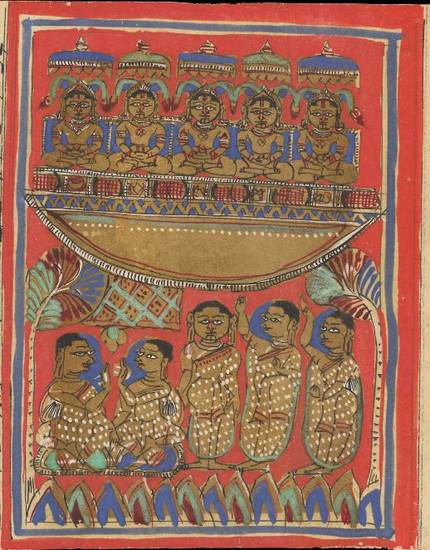
Perfect beings and paths to liberation
Image by British Library © CC0 1.0 (Creative Commons Public Domain)
The steadiness of mind and calmness that characterise the ‘perfect ascetic’ will come only if he or she has been able to conquer the four passions – kaṣāyas – of:
- anger – krodha
- pride – māna
- deceitfulness – māyā
- greed – lobha.
They can affect the soul with four degrees of intensity, ranging from the lowest to the highest.
Controlling the passions helps the individual reach the complete detachment from the affairs of the world that is the goal of monastic life. Worldly concerns include all physical needs – including the need to stop pain – and emotions. Reaching a permanently, completely calm condition where the passions are not felt at all – total detachment – means that no more karma sticks to the soul and the karma already attached is destroyed. This enables the individual to progress spiritually towards the end-goal of liberation from the cycle of rebirth.
Ascetics and women
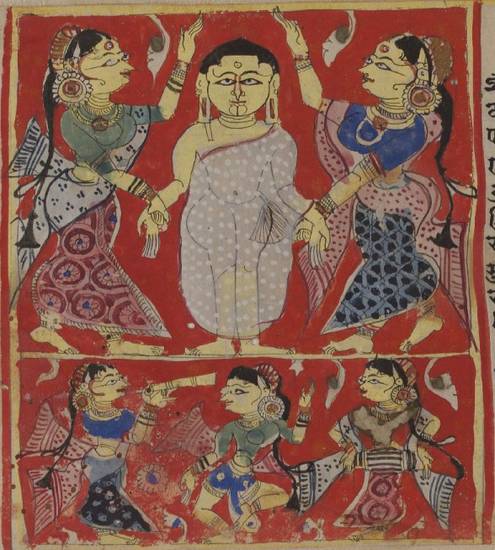
Meditating monk ignores temptation
Image by Victoria and Albert Museum © V&A Images/Victoria and Albert Museum, London
The most serious lapse in ascetic conduct comes from interaction with the opposite sex. It recognises that the lifelong vow of celibacy is generally believed to be the most difficult to keep. Though most texts discuss male mendicants only, the rules specified for monks can be thought of as applying to nuns, as this is usually the case in practice.
Male and female ascetics do not mix and they are never seen together. Jain mendicants live in small single-sex groups. Monks and nuns have separate lodgings, which are generally not on the same premises. During religious assemblies, they sit in two separate groups on each side of the centre.
Contact with women represents a crucial danger for monks, as this quotation shows:
In this world men have a natural liking for women; he who knows and renounces them, will easily perform his duties as a Śramaṇa [= ascetic].
Uttarādhyayana-sūtra, chapter 2, verse 16
translation by Hermann Jacobi
One of the most famous stories of a monk tempted to break his vow of celibacy is that of Rathanemi. Brother of Nemi, the 22nd Jina, he was charmed by Rājīmatī, herself a nun. She was the one who put him back on the right path.
‘Ten conditions of perfect chastity’
A set of prescriptions has been devised to help monks renounce women completely and become better ascetics. The rules aim to force male ascetics to avoid everything to do with women, whether directly or indirectly, so that no doubt or temptation may arise in their minds.
Chapter 16 of the Uttarādhyayana-sūtra lists ‘the ten conditions of perfect chastity‘. Note that the last four conditions do not relate to women directly, but are concerned with causes of excitement or passions that are contrary to the right path.
|
Number |
Condition |
|---|---|
|
1 |
Monks should not sleep or rest in places where women go |
|
2 |
Male mendicants should not speak to women |
|
3 |
Ascetics should not sit on the same seat as a woman |
|
4 |
Monks should not look at or think about female charms and beauty |
|
5 |
Male mendicants should not listen to women screaming, singing, laughing, giggling or crying |
|
6 |
Ascetics should not recall the pleasure and amusements they enjoyed with women in the past |
|
7 |
Mendicants should not eat well-dressed or tasty food |
|
8 |
Ascetics should not eat or drink too much |
|
9 |
Mendicants should not wear ornaments, lest they become objects of desire |
|
10 |
Ascetics should not care for sounds, colours, tastes, smells and feelings |
Penance
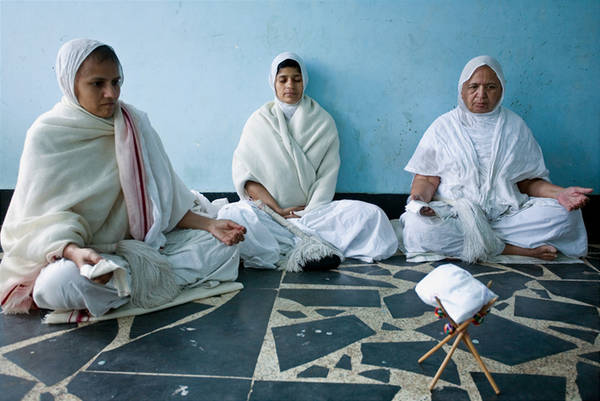
Śvetāmbara nuns meditate
Image by Claude Renault © CC BY 2.0
One efficient way to destroy the karmas that have entered an ascetic’s soul is for him or her to practise penances or austerities – tapas. There are 12 types, detailed in Chapter 30 of the Uttarādhyayana-sūtra.
Six varieties are external, and relate to control of food or mortification of the body.
|
1 |
|
|
2 |
limiting the quantity of food before being full – avamodarikā |
|
3 |
restrictions in gathering alms – bhikṣā-caryā |
|
4 |
avoiding tasty food, sauces and so on – rasa-parityāga |
|
5 |
mortification of the flesh – kāya |
|
6 |
living in isolated places – saṃlīnatā |
The other six varieties of austerities are internal. Some are concerned with areas covered in categories mentioned above.
|
1 |
expiation of sins and lapses – prāyaścitta |
|
2 |
politeness or humility – vinaya |
|
3 |
serving the teacher and other senior monks – vaiyāvṛtya |
|
4 |
study – svādhyāya |
|
5 |
|
|
6 |
rejection of the body – kāyotsarga – which means remaining motionless in whatever position one is. |
Fasting unto death
How Jains die is important because their mental state at this time determines their destiny in the next birth. They are also advised to avoid living in circumstances that would stop them from keeping vows or performing required duties. For these reasons, control over one’s death is recommended to all Jains, especially mendicants. What Jains call sallekhanā – ‘thinning out’ – or anaśana – fasting to death – implies gradually giving up food and liquids. This is believed to purify the mind and destroy all negative karma and passions. It is a difficult thing to do and must be an individual’s choice. Fasting to death is not common among lay Jains and is known as ‘a sage’s death’:
Death against one’s will is that of ignorant men, and it happens to the same individual many times. Death with one’s will is that of wise men, and at best it happens but once.
Uttarādhyayana-sūtra, chapter 5, verse 3
translation by Hermann Jacobi
The mendicant who decides to die in this way generally goes to a secluded place on a hilltop, because high places are considered holy. Inscriptions and memorials found in places such as Shravana Belgola are evidence of this practice. It is still a part of mendicant life today, especially among Digambaras, and is considered to be something remarkable.
The ‘bad ascetic’
Few Jains choose the life of a mendicant, which is why monks and nuns are revered. Mendicants accept that the ideal of the ‘perfect ascetic’ is an extremely hard one to live up to. The concept of the ‘bad ascetic’ is the opposite extreme. Though they may fall short of the ideal, most Jains who become monks and nuns are neither perfect nor bad.
The Uttarādhyayana-sūtra again provides an outline of monastic behaviour. Chapter 17 gives a vivid picture of all that a bad ascetic does. This topic is often attractively dealt with in manuscript paintings in copies of the text. The behaviour of such mendicants is the opposite of all the rules mentioned above.
The conclusion is:
Such a monk, who, like the heretics, does not protect himself from sins, who though having the appearance of a monk is the lowest among his worthy brethren, is despised in this world like poison; he is nobody in this world and in that beyond. But he who always avoids these sins, and is pious among his brethren, is welcomed in this world like nectar; he conquers this world and the next.
translation by Hermann Jacobi
Reading
- History of Jaina Monachism from Inscriptions and Literature
Shantaram Bhalchandra Deo - Deccan College Dissertation series; volume 17
Deccan College Postgraduate and Research Institute; Pune, Maharashtra, India; 1956
- The Jains
Paul Dundas - Library of Religious Beliefs and Practices series; series editor John Hinnels and Ninian Smart; volume 14
Routledge Curzon Press; London, UK; 2002
- Historical Dictionary of Jainism
Kristi L. Wiley - Historical Dictionaries of Religions, Philosophies, and Movements series; series editor Jon Woronoff; volume 53
Scarecrow Press; Maryland, USA; 2004
Links
- A Śvetāmbara nun descends from Shatrunjaya
-
A nun from a Śvetāmbara Mūrtipūjaka mendicant order runs barefoot down the steps leading down from Mount Shatrunjaya. This temple-city in Gujarat is one of the most significant Śvetāmbara Mūrtipūjaka pilgrimage sites. The steep path from the foot to the summit, where the principal shrines are found, has around 4000 steps.
- Digambara nuns pluck out their hair
-
In the keśa-loca rite, part of the renunciation ceremony of dīkṣā, new monks and nuns pull out their hair, which indicates indifference to worldly concerns, including pain. Ashes are smeared on the roots of the hair, making it easier to pluck out and reducing pain. In the Digambara sects, keśa-loca is a public ceremony. This rite took place among Digambara nuns, as shown by the peacock-feather broom – piñchī – one of them holds in this YouTube video. The dīkṣā was conferred by the nun Gaṇinī Āryikā Viśuddhamati mātājī in Kota, Rajasthan, a few years ago, though the precise date is unknown. The language used is Hindi, with Sanskrit and Prakrit for recitations from the scriptures.
- Five Great Monastic Vows
-
Pravin K. Shah writes about the Five Great Vows taken by Jain monks and nuns. The information is provided by the Jainism Literature Center, associated with the Faculty of Arts and Sciences at Harvard University.
http://www.fas.harvard.edu/~pluralsm/affiliates/jainism/jainedu/5greatvows.htm
- Introduction to Jainism – part 1
-
This extract from a BBC documentary called The Frontiers of Peace introduces the ancient Indian religion of Jainism. A Śvetāmbara monk explains some of the main principles of Jainism, especially non-violence. The programme mentions the influence of Jains in India and on the work of Mahātma Gandhi. This 2010 YouTube video is the first of four parts. See the next part at: http://www.youtube.com/watch?v=UHMQRmRKh_U
- Introduction to Jainism – part 2
-
This extract from a BBC documentary called The Frontiers of Peace explores the relationship between Jain traditions and modernity. A Jain lay man tells how he reconciles his faith with his industrial business interests. A Śvetāmbara monk explains the significance of his monastic broom – known as a rajoharaṇa or oghā – including the eight auspicious symbols wrapped around the handle. A nun leads lay followers in the rite of confession – pratikramaṇa. A young woman creates auspicious symbols in rice as an offering as she talks about her decision to become a nun. This 2010 YouTube video is the second of four parts. See the next part at: www.youtube.com/watch
- Introduction to Jainism – part 3
-
This extract from a BBC documentary on Jainism called The Frontiers of Peace explores the concept of renunciation. The video follows a young woman's decision to become a nun and a rich lay man's faith. The ritual of keśa-loca is filmed, in which monks and nuns pull out their hair. The lay man is shown making the auspicious symbols of the svastika, three dots representing the 'three jewels' of right insight, right knowledge and right conduct and the horizontal crescent of the siddha-śilā, where liberated souls live. This 2010 YouTube video is the third of four parts. See the next part at: http://www.youtube.com/watch?v=670KFhISeUk
- Introduction to Jainism – part 4
-
This extract from a BBC documentary called The Frontiers of Peace explores the mendicant element of the traditional fourfold community. A man talks about his decision to stop being a Jain monk and return to the householder life, while a young woman fulfils her wish to becomes a nun. This 2010 YouTube video is the last of four parts. See the first part at: http://www.youtube.com/watch?v=IPscKFV5yKU
- Jain mantras
-
This 2007 animation from YouTube features a Digambara monk singing the fundamental Jain sacred formulas. The second is the Namaskāra-mantra, also called the Navkār-mantra or Namokār-mantra. A very old mantra in Prakrit, it can be sung to various melodies. It is chanted daily to the 'five types of beings worthy of worship' or Supreme Beings':
- enlightened teachers – Arhats or Jinas
- liberated souls – siddhas
- mendicant leaders – ācāryas
- teachers – upādhyāyas
- mendicants – sādhus.
Then comes a short mantra about the emptiness of the world of rebirths and the celebration of the 'four auspicious things' or 'four refuges':
- Arhat
- siddha
- monks
- law – dharma.
- +
- aAbhavya
- aAbhinandana
- aAbhiṣeka
- aĀcāra
- aĀcārāṅga-sūtra
- aĀcārya
- aAchalbhrata
- aAḍhāī-dvīpa
- aAdharma
- aAdho-loka
- aAdhyayana
- aAdvaita Vedānta
- aĀgama
- aAghātīya
- aAghātīya-karman
- aAgnibhuti
- aAgra
- aĀhāra
- aAhiṃsā
- aAhimsa Day
- aAjita
- aAjīva
- aAkampit
- aĀkāśa
- aAkbar the Great
- aAkṣaya-tṛtīyā
- aAlauddin Khalji
- aAlbert Einstein
- aAllah
- aAlms
- aĀlocanā
- aAloka-ākāśa
- aAmāri
- aAmbikā or Kūṣmāṇḍinī
- aAnagāra
- aAnanta
- aAnarthadaṇḍa
- aAnaśana
- aAnekānta-vāda
- aAṅga
- aAniconism
- aAnojjā
- aAntarāla
- aAntarāya-karma
- aAṇu
- aAṇu-vrata
- aAnukampā
- aAnuprekṣā
- aAnusvāra
- aApabhraṃśa
- aAparigraha
- aAra
- aĀrambha
- aĀrambhaja
- aĀratī
- aArdhamāgadhī Prākrit
- aArhaṃ
- aArhat
- aArśana-āvaraṇīya-karma
- aĀrta-dhyāna
- aĀryikā
- aĀryikā Jñānamati
- aĀśātanā
- aĀścarya
- aAscetic
- aAsceticism
- aAshram
- aAspiration
- aĀsrava
- aAṣṭa-maṅgala
- aAṣṭāpada
- aAstikāya
- aAstrolabe
- aAsura
- aAtheism
- aAticāra
- aAtiśayakṣetra
- aAtithisaṃvibhāgavrata
- aĀtma-vāda
- aĀtman
- aAuṃ
- aAurangzeb
- aAuspicious
- aAusterity
- aAvadhāna
- aAvadhi-jñāna
- aĀvaraṇī-yakarman
- aAvasarpiṇī
- aAvatāra
- aAvidyā
- aAxiom
- aĀyāga-paṭa
- aĀyambil
- aĀyu-karma
- aĀyurveda
- bBabur
- bBāhubali
- bBaladeva
- bBālāvabodha
- bBandha
- bBasadi
- bBazaar
- bBhadrankarvijay
- bBhagavant
- bBhaktāmara-stotra
- bBhakti
- bBhale
- bBharata
- bBhāṣā
- bBhāṣya
- bBhaṭṭāraka
- bBhāva
- bBhāva-pūjā
- bBhāvanā
- bBhavana-vāsin
- bBhavya
- bBhavyatva
- bBhaya
- bBhoga-bhūmi
- bBhogopabhoga
- bBodhi
- bBollywood
- bBrahmā
- bBrahma-deva
- bBrahmacārī
- bBrāhmaṇa
- bBraj Bhāṣā
- bBright fortnight
- bBritish Raj
- bBuddha
- bBuddhi-sagar
- bBuddhism
- bBuddhist
- cCaitya
- cCaityavāsin
- cCakravartin
- cCakreśvarī
- cCāmara
- cCandanā
- cCandragupta
- cCandraprabha
- cCanon
- cCāritra
- cCāritramohanīya-karman
- cCarũrī
- cCaste
- cCaturvidha-saṅgha
- cCaturviṃśati-stava
- cCāturyāma
- cCE
- cCelibacy
- cCha
- cChadmastha
- cChastity
- cCheda-sūtra
- cChristian
- cChristianity
- cClergy
- cCloning
- cColophon
- cCommentary
- cConch
- cConfession
- cCongregation
- cConsecration
- cCosmology
- cCremation
- cCrore
- cCult
- cCūrṇi
- dDādā-guru
- dDalit
- dDāna
- dDaṇḍa
- dDark fortnight
- dDarśana
- dDarśanamohanī-yakarman
- dDaśa-lakṣaṇa-parvan
- dDeity
- dDelhi Sultanate
- dDerāsar
- dDeśāvakāśika-vrata
- dDetachment
- dDevanāgarī
- dDevānandā
- dDevarddhi-gani
- dDevotee
- dDhamal
- dDhanuṣ
- dDhāra
- dDharma
- dDharma-dhyāna
- dDharma-sāgara
- dDharmastikaya
- dDhātakīkhaṇḍa
- dDholak
- dDhyāna
- dDiaspora
- dDig-vrata
- dDigambara
- dDīkṣā
- dDisciple
- dDīvālī
- dDivya-dhvani
- dDNA
- dDoctrine
- dDogma
- dDonor
- dDoṣa
- dDravya
- dDravya-pūjā
- dDrone
- dDuṣamā
- dDuṣamā-duṣamā
- dDuṣamā-suṣamā
- dDveṣa
- dDvīpa
- eEast India Company
- eEightfold Path
- eEkānta-vāda
- eEkendriya
- eElder
- eElders
- eEschatology
- eEtc up to
- fFarmān
- fFast
- fFatehpur Sikri
- fFestival
- fFestschrift
- fFiruz Shah
- fFly-Whisks
- fFolio
- fFour Noble Truths
- gGaccha
- gGaṇa
- gGaṇadhara
- gGanadharavada
- gGaṇeśa
- gGaṇin
- gGarba
- gGarbha
- gGarbha-gṛha
- gGaruḍa
- gGati
- gGene
- gGenomics
- gGhātī-yakarman
- gGhātīya
- gGhaznavid
- gGhiyasuddin Tughlaq
- gGhurid
- gGloss
- gGotra-karma
- gGujarāt
- gGujarati
- gGuṇa
- gGuṇa-sthāna
- gGuṇa-vrata
- gGupti
- gGuru
- gGuruṇī
- hHagiography
- hHajj
- hHaṃsa
- hHaribhadra
- hHariṇaigameṣin
- hHasta
- hHeresy
- hHiṃsā
- hHindi
- hHindu
- hHinduism
- hHīravijaya
- hHoroscope
- hHrīṃ
- hHumayun
- hHymn
- iIconoclasm
- iIconography
- iIdol
- iIndian Independence
- iIndology
- iIndra
- iIndrabhūti Gautama
- iIndriya
- iInitiation
- iIntercession
- iInvocation
- iIQ
- iIslam
- iIslamicate
- iIṣṭadevatā
- iĪśvara
- jJagat
- jJahangir
- jJain
- jJaina Devanāgarī
- jJaina Śaurasenī
- jJaina-dharma
- jJainaśāsana
- jJainness
- jJaisalmer
- jJamāli
- jJambū-dvīpa
- jJames Burgess
- jJanma
- jJanma-kalyāṇa
- jJarā
- jJāti
- jJina
- jJina-āgama
- jJina-bhavana
- jJina-bimba
- jJina-mātā
- jJinacandra-sūri
- jJinadatta
- jJinaprabha
- jJīva
- jJñāna
- jJñāna-āvaraṇīya-karma
- jJñāna-āvarṇiya
- jJñānsundar
- jJyotiṣka
- kKāla
- kKālakācārya-kathā
- kKālidāsa
- kKalpa-sūtra
- kKalpa-vṛkṣa
- kKalyāṇaka
- kKalyanvijay
- kKamaṇḍalu
- kKamaṭha
- kKarma
- kKarma-bhūmi
- kKarma-grantha
- kKarma-prakṛti
- kKarma-vāda
- kKarmon
- kKarnataka
- kKaṣāya
- kKathā
- kKāvya
- kKāya
- kKāyotsarga
- kKeśa-loca
- kKetu
- kKevala-jñāna
- kKevalin
- kKhalji
- kKharatara-gaccha
- kKnowledge
- kKriyā
- kKriyā-vāda
- kKṛṣṇa
- kKṣamā-śramaṇa
- kKṣapakaśreṇi
- kKṣatriya
- kKṣullaka
- kKulakara
- kKundakunda
- kKunthu
- lLabdhi
- lLaity
- lLakh
- lLāñchana
- lLands of Action
- lLaukāntika
- lLavaṇa-samudra
- lLeśyā
- lLiṅga
- lLinguistics
- lLoka
- lLoka-ākāśa
- lLoka-puruṣa
- lLoka-vāda
- lLotus
- lLotus lake
- mMadhya-loka
- mMahā-videha
- mMahā-vrata
- mMahābhārata
- mMahāmastakābhiṣeka
- mMāhārāṣṭra
- mMāhārāṣṭrī Prākrit
- mMahattarā Yākinī
- mMahāvīr Jayantī
- mMahāvīra
- mMakāra
- mMakkhali Gośāla
- mMalli
- mMāna-stambha
- mManaḥ-paryāya-jñāna
- mMaṇḍala
- mMaṇḍapa
- mMandit
- mMaṅgala
- mMantra
- mMantras
- mManuṣya-loka
- mMarāṭhī
- mMārgaṇā
- mMartyr
- mMarudevī
- mMaṭha
- mMati-jñāna
- mMauryaputra
- mMecca
- mMendicant lineage
- mMetarya
- mMiracle
- mMithyādṛṣṭi
- mMohandas Gandhi
- mMohanīya-karma
- mMokṣa
- mMonastic order
- mMonasticism
- mMonk
- mMonotheism
- mMosque
- mMount Meru
- mMount Sammeta
- mMṛgāvatī
- mMughal
- mMuhammad
- mMuhammad bin Tughlaq
- mMuhpattī
- mMūla-sūtra
- mMūlaguṇa
- mMumbaī
- mMuni
- mMunisuvrata
- mMurad Bakhsh
- mMūrti-pūjaka
- mMuslim
- mMysticism
- nNābhi
- nNāga-kal
- nNāgapurīya Tapā-gaccha
- nNāgarī
- nNāma-karma
- nNamaskāra-mantra
- nNami
- nNandīśvara-dvīpa
- nNandivardhana
- nNandyāvarta
- nNāraka
- nNāraki
- nNasalisation
- nNātha
- nNavrātrī
- nNaya-vāda
- nNemi
- nNidāna
- nniggaṃthāṇa vā 2
- nniggaṃtho vā 2
- nNigoda
- nNihnava
- nNikṣepa
- nNirgrantha
- nNirjarā
- nNirvāṇa
- nNiryukti
- nNiṣidhi
- nNitya
- nNiyati
- nNo-kaṣāya
- nNudity
- nNun
- oOcean of milk
- oOmniscience
- oOrdination
- ppa°
- pPadmaprabha
- pPadmāsana
- pPadmāvatī
- pPādukā
- pPalanquin
- pPalette
- pPañca-muṣṭi
- pPāṇḍava
- pPaṇḍit
- pPandit Dalsukh D. Malvania
- pPandit Sukhlalji
- pPāṇipātra
- pPāpa
- pParamātman
- pParameṣṭhin
- pPāraṇā
- pParigraha
- pPariṇāma
- pParīṣaha
- pParokṣa
- pPārśva
- pPārśvanātha
- pParyāya
- pParyuṣaṇ
- pPaṭa
- pPatan
- pPātra
- pPenance
- pPersian
- pPhala
- pPhilology
- pPicchikā
- pPilgrimage
- pPīr
- pPolymath
- pPoṣadha
- pPossession
- pPothī
- pPrabhas
- pPradakṣiṇā
- pPradeśa
- pPrākāra
- pPrakīrṇaka-sūtra
- pPrākrit
- pPramāda
- pPramukhā
- pPrati-vāsudeva
- pPratikramaṇa
- pPratimā
- pPratiṣṭhā
- pPratyākhyāna
- pPratyakṣa
- pPravacana
- pPrāyaścitta
- pPrayer
- pPre-modern
- pPreach
- pPredestination
- pProtestant
- pProvenance
- pPudgala
- pPūjā
- pPujārī
- pPukharavara-dvīpa
- pPuṇya
- pPūrva
- pPuṣkara-dvīpa
- pPuṣpadanta
- pPyre
- qQur’an
- rRāga
- rRāhu
- rRainy season
- rRajasthan
- rRajasthani
- rRājimatī
- rRajoharaṇa
- rRajput
- rRāma
- rRāmāyaṇa
- rRangoli
- rRās-garbā
- rRasa
- rRathanemi
- rRatna-traya
- rRātri-bhojana
- rRaudra-dhyāna
- rRecto
- rRelic
- rRenunciation
- rRetroflex
- rRevatī
- %Ṛg-veda
- rRite
- rRosary
- %Ṛṣabha
- %Ṛṣabhanātha
- rRupee
- sSaciyā Mātā
- sSādhu
- sSādhvī
- sSāgāra
- sSaint
- sŚaivaism
- sŚaka-saṃvat
- sSallekhanā
- sŚalya
- sSamacatuṣṭha
- sSamādhimaraṇa
- sSamaṇi
- sSāmarambha
- sSamavasaraṇa
- sSāmāyika
- sSaṃbhava
- sSamiti
- sSaṃjñā
- sSaṃkalpaja
- sSaṃsāra
- sSamudghāta
- sSaṃvara
- sSaṃvega
- sSamyak-cāritra
- sSamyak-darśana
- sSamyak-jñāna
- sSamyaktva
- sSaṃyama
- sSanctuary
- sSandalwood
- sSaṇgha
- sSanskrit
- sSant
- sŚānti
- sSapta-bhaṅgi-naya
- sSārambha
- sSarasvatī
- sSarvajña
- sSāsan-devi
- sŚāsana-devatā
- sŚāstra
- %Ṣaṭ-jīvanikāya
- sSatī
- sSatīmātā
- sSatya
- sSchism
- sScribe
- sScripture
- sSect
- sSecularism
- sŚenāī
- sSermon
- sŚeṣavatī
- sSevā
- sSeven fields of donation
- sShah Jahan
- sShantidas Jhaveri
- sShrine
- sSiddha
- sSiddha-śilā
- sSiddhacakra or Navadevatā
- sSiddhānta
- sSiddhārtha
- sSiddhi
- sSikh
- sSikhism
- sŚikṣā-vrata
- sŚīla
- sSin
- sSindh
- sŚītala
- sŚiva
- sSkandha
- sSomanatha
- sŚraddhā
- sŚramaṇa
- sŚrāvaka
- sŚrāvakācāra
- sŚrāvikā
- sŚreyāṃsa
- sŚrī
- sŚrīvatsa
- sŚruta-jñāna
- sŚruta-pañcamī
- sSthānaka-vāsin
- sSthāpanācārya
- sSthāvara
- sSthavira
- sSthiti
- sStrīmukti
- sStūpa
- sSubcontinent
- sSudarshana
- sŚuddhi
- sSudharma
- sŚūdra
- sSufism
- sSukha
- sŚukla-dhyāna
- sSulasā
- sSultan
- sSumati
- sSundarśrī
- sSupārśva
- sSūri
- sSuṣamā
- sSuṣamā-duṣamā
- sSuṣamā-suṣamā
- sSūtra
- sSuyam me ausam! Tenam bhagavaya evamakkhayam
- sSvādhyāya
- sSvāhā
- sSvastika
- sŚvetāmbara
- sŚvetāmbara Terāpanthin
- sŚvetāmbaras
- sSwan
- sSyād-vāda
- tTabla
- tTantra
- tTapā-gaccha
- tTapas
- tTāraṇ Svāmī Panth
- tTattva
- tTattvārtha-sūtra
- tTemple
- tTemple-city
- tThe Enlightenment
- tTheology
- tThree worlds
- %Ṭīkā
- tTilaka
- tTīrtha
- tTīrthaṃkaranāma-karman
- tTīrthankara
- tTransliteration
- tTrasa
- tTrasa-nāḍī
- tTriśalā
- tTriṣaṣṭi-śalākā-puruṣa-caritra
- tTti bemi
- tTughlaq
- tTunk
- uUdumbara
- uUniversal History
- uUpādhyāya
- uUpāṅga
- uUpaniṣads
- uUpāsaka
- uUpasarga
- uUpāśraya
- uŪrdhva-loka
- uUtsarpiṇī
- uUttarādhyayana-sūtra
- vVāhana
- vVaimānika
- vVairāgya
- vVaiṣṇava
- vVaiśramaṇa
- vVaiśya
- vValabhī
- vVanaspatikāya
- vVandana
- vVaṇik
- vVarṇa
- vVāsudeva
- vVāsupūjya
- vVayubhūti
- vVeda
- vVedanīya-karma
- vVegetarianism
- vVehicle
- vVernacular
- vVerso
- vVidyā
- vVidyā-devī
- vVihāra
- vVijñapti-patra
- vVikrama-saṃvat
- vVikṛti
- vVimala
- vVinaya
- vVipāka
- vVirji Vora
- vVirodhaja
- vVīrya
- vVisarga
- vViṣṇu
- vVītarāga
- vVizier
- vVotive
- vVow
- vVrata
- vVS
- vVyakta
- vVyantara
- vVyasana
- yYakṣa
- yYakṣī
- yYantra
- yYaśoda
- yYaśovijaya
- yYati
- yYātrā
- yYoga
- yYoginī
- yYojana


